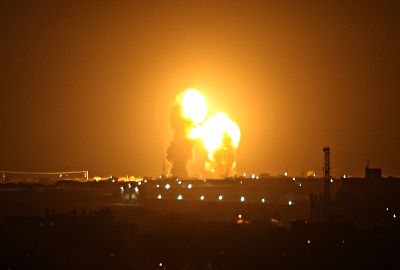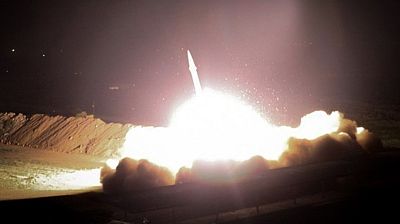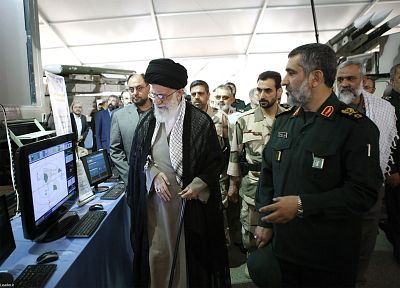False claims of American casualties and that Iran had declared war on the U.S. added to growing inaccuracies on social media.
Not long after Iran fired ballistic missiles at two Iraqi air bases, targeting U.S. forces, misinformation began appearing on social media, including outdated photos and videos claiming to show the attacks.
A Twitter user responded Tuesday to a tweet from President Donald Trump with an image claiming to be Ayn al-Asad air base under attack. The image was actually from a November 2019 incident in the Gaza Strip.
The Iranian Fars News Agency tweeted out an outdated image claiming to be of a missile launch. The photo is actually from 2017 and shows a missile heading toward Syria.
Similarly, an image showing Iran's supreme leader, Ayatollah Ali Khamenei, with his name misspelled circulated online Tuesday night. It claimed to show Khamenei supervising the attack on Ain al-Asad airbase, but appears to be an edited version of an image released by Iran in 2014 during an Islamic Revolutionary Guards Corps exhibition.
NBC News' Social Newsgathering team that works to find, verify and report on trending and breaking news stories debunked this material that turned out to be out of date, out of place and misidentified.
With some simple online verification tools like Google's reverse image search feature, anyone can check if a photo tweet, YouTube video or image floating around online is a complete fabrication.
In addition to erroneous photos and videos that have been shared online, a number of social media accounts posted false claims of American casualties in Tuesday's attacks and that Iraq had declared war on the U.S.
No Americans were harmed in the attack, Trump said Wednesday in an address to the nation.
"The American people should be extremely grateful and happy no Americans were harmed in last night's attack by the Iranian regime," Trump said. "We suffered no casualties, all of our soldiers are safe, and only minimal damage was sustained at our military bases."
After last week's killing of Iranian Gen. Qassem Soleimani, many people took to social media to voice fears about the possibility of a military draft if the U.S. were to declare war on Iran.
The Selective Service System, the agency that handles registration of people eligible for the draft, said its site was experiencing high traffic volumes "due to the spread of misinformation" and noted the agency was "conducting business as usual."
"In the event that a national emergency necessitates a draft, Congress and the President would need to pass official legislation to authorize a draft," the agency tweeted.
The U.S. Army Recruiting Command released a statement Tuesday discrediting text messages people reported receiving that informed them they had been selected for the draft.
"U.S. Army Recruiting Command has received multiple calls and emails about these fake text messages and wants to ensure Americans understand these texts are false and were not initiated by this command or the U.S. Army," the USAREC wrote in a statement.
The online misinformation surrounding tensions between Iran and the U.S. started even before the attacks when one U.S. politician posted a manipulated image on Twitter.
Rep. Paul Gosar, R-Ariz., tweeted a fake photo Monday of former President Barack Obama shaking hands with Iranian President Hassan Rouhani. He captioned the tweet, "The world is a better place without these guys in power."
Though the tweet received more than 22,000 likes, many users were quick to point out the photo was not real and had actually been circulating for years.
The manipulated image allegedly showing Obama with Rouhani was used in a political action committee's advertisement for Sen. Ron Johnson, R-Wis., back in 2015, according to FactCheck.org.
The photo appears to be a manipulated image of Obama shaking hands with former Indian Prime Minister Manmohan Singh in 2011.
Gosar later defended the tweet, writing, in part, "No one said this wasn't photoshopped. No one said the president of Iran was dead. No one said Obama met Rouhani in person."














